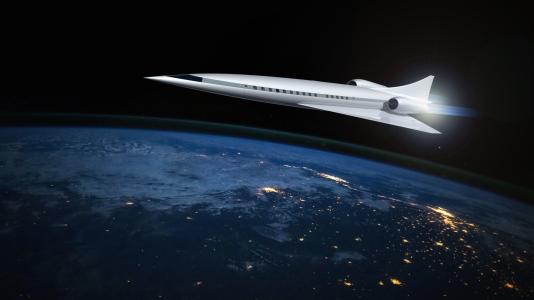Scientists from Argonne and NASA collaborate to improve hypersonic jet engines.
The breakthrough could have use for both defense and commercial applications.
Chuck Yeager, a U.S. Air Force pilot, became the first person to fly faster than the speed of sound nearly 75 years ago. Since then, engineers have been pushing the limits of ultrafast flying, achieving speeds that most of us can only dream.
Today’s military fighter jets, such as the F-15, often exceed Mach 2, or twice the speed of sound. That’s the level of supersonic travel. An airplane goes faster than 3,000 miles per hour on a hypersonic flight – Mach 5 and beyond. You could get from New York to Los Angeles on a lunch break at that speed.
Since the 1950s, hypersonic speeds have been attainable because of the same propulsion technology used in rockets. Engineers and scientists are working on new jet engine designs to make the hypersonic flight more widespread and significantly less expensive than a rocket launch. Hypersonic aircraft might serve as reusable launch vehicles for spacecraft, for example, and these new concepts provide a huge possibility for commercial travel, space research, and national security.
Computer simulations are used to determine what is possible before any aircraft is built and tested. Researchers have long utilized computational fluid dynamics (CFD) to anticipate how a plane in flight will interact with the forces around it, among other things. CFD is a branch of science that deals with numerically representing the behavior of fluids like air and water.
An aircraft capable of breaking the sound barrier brings new levels of complexity to an already computationally intense exercise. Researchers at the U.S. Department of Energy’s (DOE) Argonne National Laboratory and the National Aeronautics and Space Administration (NASA) are pioneering the use of artificial intelligence to streamline CFD simulations and accelerate the development of barrier-breaking aircraft.
The exhilarating journey of supersonic flight results in equally exhilarating fluid dynamics. The airplane generates a shock wave that contains air that is hotter, denser, and higher in pressure than the surrounding air as it exceeds the speed of sound. The air friction caused at hypersonic speeds is so intense that it might melt sections of a typical commercial jet.
CFD simulations must account for major shifts in air, not only around the plane, but also as it moves through the engine and interacts with fuel. Air-breathing jet engines, as they are called, draw in oxygen to burn fuel as they fly. In a conventional plane, fan blades push the air along. But at Mach 3 and up, the movement of the jet itself compresses the air. These aircraft designs, known as scramjets, are key to achieving levels of fuel efficiency that rocket propulsion cannot. But running them in hypersonic flight, it’s been said, is like lighting a match in a hurricane and keeping it lit.
“Because the chemistry and turbulence interactions are so complex in these engines, scientists have needed to develop advanced combustion models and CFD codes to accurately and efficiently describe the combustion physics,”
said Sibendu Som, a study co-author and interim center director of Argonne’s Center for Advanced Propulsion and Power Research.
NASA has a hypersonic CFD code called VULCAN-CFD that can simulate how combustion operates in this volatile environment. The code works with multidimensional flamelet tables, with each flamelet representing a one-dimensional flame. These different images of burning fuel are stored in one big collection in the data tables, which takes a lot of computer memory to process. Argonne scientists employed machine learning approaches to lower the intense memory needs and computational expense of simulating supersonic fuel burning in a recently published study.
“Working with NASA gave us the opportunity to integrate our novel developments in a state-of-the-art CFD code, and also to further improve the developments for more efficient design and optimization of hypersonic jets,”
said Argonne computational scientist Sinan Demir, a study co-author.
The flamelet table, generated by Argonne-developed software, was used to train an artificial neural network. In an artificial neural network, which is a subset of machine learning, a computer derives insights from data the way a human brain would. Here, the network used values from the flamelet table to learn shortcuts to “answers” about how combustion behaves in supersonic engine environments.
“The partnership has enhanced the capability of our in-house VULCAN-CFD tool by leveraging the research efforts of Argonne, allowing us to analyze fuel combustion characteristics at a much-reduced cost,”
said Robert Baurle, a research scientist at NASA Langley Research Center.
The approach has been validated in previous studies for subsonic applications. The new research applies it to supersonic and hypersonic problems, using the high-performance computing resources at Argonne’s Laboratory Computing Resource Center. DOE’s Office of Science and NASA’s Langley Research Center provided funding.
“The partnership between Argonne and NASA is valuable because our models and software can be applied effectively to theirs,” Demir said. “It’s a way to do high-speed propulsion CFD simulations differently.”
The paper detailing the new neural network framework, entitled “Deep neural network based unsteady flamelet progress variable approach in a supersonic combustor,” was presented in early January at the American Institute of Aeronautics and Astronautics SciTech Forum. In addition to Demir and Som, other authors of the paper include Argonne’s Prithwish Kundu (who is now with Euler Motors) and Cody Nunno (no longer with Argonne), as well as NASA Langley’s Robert Baurle and Tomasz Drozda.

